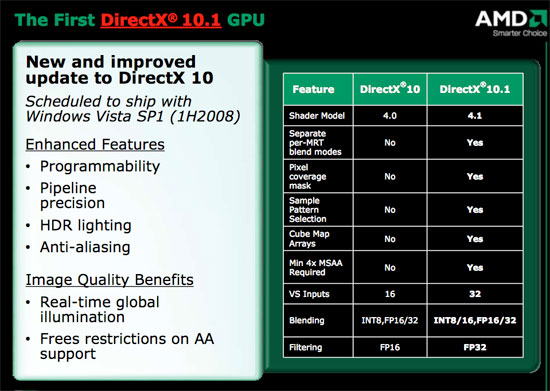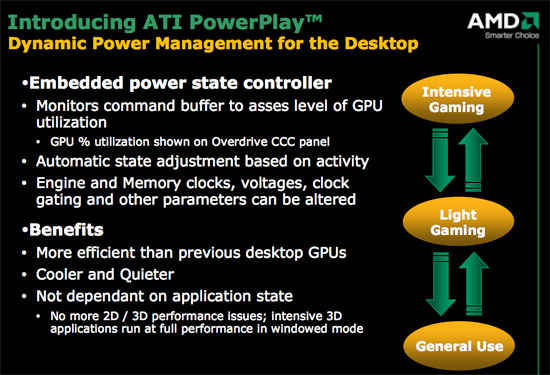ATI Radeon HD 3870 & 3850: A Return to Competition
by Anand Lal Shimpi & Derek Wilson on November 15, 2007 12:00 AM EST- Posted in
- GPUs
New Features you Say? UVD and DirectX 10.1
As we mentioned, new to RV670 are UVD, PowerPlay, and DX10.1 hardware. We've covered UVD quite a bit before now, and we are happy to learn that UVD is now part of AMD's top to bottom product line. To recap, UVD is AMD's video decode engine which supports decode, deinterlacing, and post processing for video playback. The key features of UVD are full decode support for both VC-1 and H.264. MPEG-2 decode is also supported, but the entropy decode step is not performed for MPEG-2 video in hardware. The advantage over NVIDIA hardware is the inclusion of entropy decode support for VC-1 video, but this tends to be overplayed by AMD. VC-1 is lighter weight than H.264, and the entropy decode step for VC-1 doesn't make or break playability even on lower end CPUs.
DirectX 10.1 is basically a release of DirectX that clarifies some functionality and adds a few features. Both AMD and NVIDIA's DX10 hardware support some of the DX10.1 requirements, but since they don't support everything they can't claim DX10.1 as a feature. Because there are no capability bits, game developers can't rely on any of the DX10.1 features to be implemented in DX10 hardware.

It's good to see AMD embracing DX10.1 so quickly, as it will eventually be the way of the world. The new capabilities that DX10.1 enables are enhanced developer control of AA sample patterns and pixel coverage, blend modes can be unique per render target rather, vertex shader inputs are doubled, fp32 filtering is required, and cube map arrays are supported which can help make global illumination algorithms faster. These features might not make it into games very quickly, as we're still waiting for games that really push DX10 as it is now. But AMD is absolutely leading NVIDIA in this area.
Better Power Management
As for PowerPlay, which is usually found in mobile GPUs, AMD has opted to include broader power management support in their desktop GPUs as well. While they aren't to wholly turn off parts of the chip, clock gaiting is used, as well as dynamic adjustment of core and memory clock speed and voltages. The command buffer is monitored to determine when power saving features need to be applied. This means that when applications need the power of the GPU it will run at full speed, but when less is going on (or even when something is CPU limited) we should see power, noise, and heat characteristics improve.

One of the cool side effects of PowerPlay is that clock speeds are no longer determined by application state. On previous hardware, 3d clock speeds were only enabled when a fullscreen 3D application started. This means that GPU computing software (like folding@home) was only run at 2D clock speeds. Since these programs will no doubt fill the command queue, they will get full performance from the GPU now. This also means that games run in a window will perform better which should be good news to MMO players everywhere.
But like we said, dropping 55nm parts less than a year after the first 65nm hardware is a fairly aggressive schedule and one of the major benefits of the 3800 series and an enabler of the kind of performance this hardware is able to deliver. We asked AMD about their experience with the transition from 65nm to 55nm, and their reply was something along the lines of: "we hate to use the word flawless... but we're running on first silicon." Moving this fast even surprised AMD it seems, but it's great when things fall in line. This terrific execution has served to put AMD back on level competition with NVIDIA in terms of release schedule and performance segment. Coming back from the delay in R600 to hit the market in time to compete with 8800 GT is a huge thing and we can't stress it enough. To spoil the surprise a bit, AMD did not outperform 8800 GT, but this schedule puts AMD back in the game. Top performance is secondary at this point to solid execution, great pricing, and high availability. Good price/performance and a higher level of competition with NVIDIA than the R600 delivered will go a long way to reestablish AMD's position in the graphics market.
Keeping in mind that this is an RV GPU, we can expect AMD to have been working on a new R series part in conjunction with this. It remains to be seen what (and if) this part will actually be, but hopefully we can expect something that will put AMD back in the fight for a high end graphics part.
Right now, all that AMD has confirmed is a single slot dual GPU 3800 series part slated for next year, which makes us a little nervous about the prospect of a solid high end single GPU product. But we'll have to wait and see what's in store for us when we get there.










117 Comments
View All Comments
nowayout99 - Friday, November 16, 2007 - link
I don't see a noise slide...But actually, Anand, noise may be a deciding factor for me. I'd really like to know what the cards sound like vs. the GT8800, particularly the 3870, if you guys could come back to it.
starjax - Thursday, November 15, 2007 - link
What about testing with updated drivers? I understand that the HIS HD3870 cards are shipping with catalyst 8.43 drivers.Comdrpopnfresh - Thursday, November 15, 2007 - link
How do you guys decide the intermediate slopes of the graphs between them? Some of them look like cubic regressions...Bram van der Heijden - Thursday, November 15, 2007 - link
Just one thing i want to add.I think the last year AMD is really screwing up... dunno what there doing, but they aren't able to beat Intel, they aren't able to beat nVidia. Something went totally wrong over there. Marketing, Financial, Corporate launching strategies whatever... their screwing up.
Leadthorns - Thursday, November 15, 2007 - link
Anand,How about the image quality? Some reviews claim its marginally better on the ati card than the 8800gt. Whats your take?
Bram van der Heijden - Thursday, November 15, 2007 - link
Best Anand, and other readers.I find it startling to see you making an assumption that's already a fact: "The Radeon HD 3870 becomes even more attractive the more expensive the 8800 GT is and the opposite is true the cheaper it gets; if the 8800 GT 512MB was available at $219, then the 3870 doesn't stand a chance."
I'm allready able to order Club3D 8800GT's 512MB for 208,- EURO's and even XFX's for about 212,45 EURO's... so thats even less in dollars. CLub3D is a company that builds good quality reference cards, so no suprises afterwards and XFX you all know.
So... for such a good site as Anand's i find it a bit strange you are not aware of this, and living by the quote stated above... this allready blows away the 3870... though luck again AMD.
Anyone interested in these cards haha, check out BEE-CT
Regards,
a Dutch bloke.
MrKaz - Thursday, November 15, 2007 - link
There are rumors that in my country the ATI 3850 256MB version will cost 140€.160€ for the 512MB and around 200€ for the 3870.
So this is in line with what you say.
(all values have VAT)
About the good luck, I think even with the slightly slower card the DX10.1 capabilities will be a selling point.
Just ask the guys that bought the faster X800 over the 6800 and now can’t play some SM3 games.
jcromano - Thursday, November 15, 2007 - link
One Euro is worth about 1.46 USD these days, no?So the 208 Euro card would cost about 304 USD, right?
Jim
Bram van der Heijden - Thursday, November 15, 2007 - link
Hmmm. back to school...That would mean 208/1.46 = 142 something...
Bram van der Heijden - Thursday, November 15, 2007 - link
but it's not like that... damn.. ur right... that's pretty expensive...I was wrong... sry.